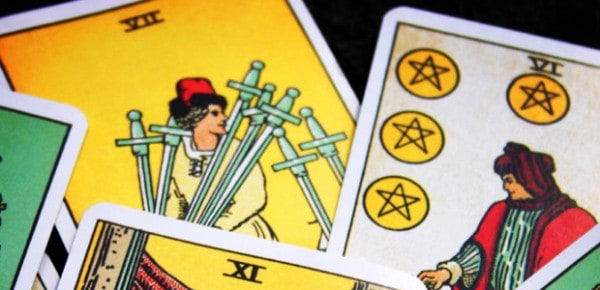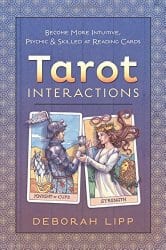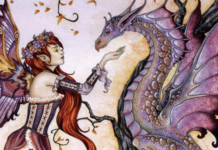
 Tarot Interactions: Become More Intuitive, Psychic, and Skilled at Reading Cards, by Deborah Lipp
Tarot Interactions: Become More Intuitive, Psychic, and Skilled at Reading Cards, by Deborah Lipp
Llewellyn Worldwide, 9780738745206, 251 pp., 2015
When I picked up Tarot Interactions by Deborah Lipp, I was expecting a fairly standard dry read with perhaps some advice on spreads and card meanings. Many books on the tarot tend to read as encyclopedias, which if you’re learning is very helpful, but not very exciting. I was completely surprised to find this book to be a rich and engaging guide for actually becoming a stronger tarot reader. This is very well-written book with practical exercises and unique anecdotes that show how varied the experience of reading can be for both the card reader and the client.
I am not a beginner when it comes to the world of tarot. I read cards professionally,1 but even I found a few practices in the book that would help me deepen my skill with the cards. Although I have long since looked at the cards as more than just the meanings in the little white book, Lipps’ suggestions of combining the readings with other practices such as numerology, for example, gave me pause and made me want to begin to investigates the ways I can tie my reading into more of my spiritual practice.
I guess I shouldn’t have been so surprised, because one of the first things that is said in the book is that it is not for beginners. This is a bit misleading and, in fact, I would recommend this book to anyone who is looking to learn to read cards, especially if they want to learn to read for other people. This book is not for those looking to understand what each card means, although there is a quick reference in the back of the book with that information. Individual card meanings are not the focus. Instead, Tarot Interactions is based around learning the different ways that cards interact with each other in readings. This focus and the approachable way that it is written makes it a perfect book for the beginner-to-intermediate reader. It is a good resource for the reader that has the basics of tarot down but needs more instruction on how cards and readings actually work.
The entirety of the book is focused on how to read the cards for deeper meaning. For example, the book begins with how to draw meaning from the images on the cards to identify what the possible focus of a card may be. Every card has multiple directions which can be at play. You’ve drawn the Ace of Cups, is this about a new beginning? Something that has already started or is going to start soon? Is this a new romance or a new baby? How do you know for sure? Lipp suggests ways to learn to trust your intuition to figure out which of the various possibilities the cards want to communicate to you.
Although you can use the skills gained from the text for your personal readings and there are multiple exercises that focus on reading for yourself, from the beginning, this is clearly a text that is dedicated to the idea of reading for others. To this end, there are whole chapters dedicated to the practice of reading for tarot for people you know and those that you don’t. The main difference that Lipp alludes to is that with people you know, you tend to have a bit of a back story, but with strangers you are reading blind. The book suggests practices that will help you build trust in your own intuition. All of the advice that the book gives is solid and clear, with information for reading from a variety of decks.
Lipp writes in-depth on the ways cards may present themselves in a reading and offers information on how to go beyond just the general definition behind a card and learn to read symbols, placement, and other less obvious interactions. She stresses a reliance on trusting what she refers to as “the psychic child,” — which can also be described as your intuition — when it comes to reading as opposed, to simply rattling off memorized definitions.
She doesn’t focus on any one practice and gives time to a variety of different interactions including the various spreads, the occurrence of the cards themselves — for example, the frequency of a suit appearing in a reading or a lack thereof — and different magical practices and spiritual disciplines outside of the actual practice of tarot. The book is written in such a way as to be relevant to people who approach the tarot from many different angles.
The book itself is broken into different interactions by chapters. Each chapter has multiple sub-sections and just by looking at the table of contents, you can easily see what each section will cover. Although you could just skip to the parts that interest you, to get the most out of the text, a full reading would be a better idea. Each section also includes a series of exercises to help you feel more connected with the new ideas and then homework to encourage you to start using them in your tarot reading. They are simple and can be accomplished quickly but if practiced can have long lasting effects on your reading.
I was especially impressed with a few of the exercises that she suggested. Although some of them did involve reading your own cards, there were many that she presented the reader with a spread to look over and write their own reactions. I find that these were better at helping me to test whether or not I was understanding the suggestions from the text. Others involved quick readings to illustrate an idea. All of them were easy to follow and could be done with minimal supplies or trouble. As I read, I found myself bookmarking many of them to go back and try later, especially the ones that were aimed at incorporating tarot into other activities in your daily life. For example, there was a suggestion on how to incorporate tarot into fiction writing to help with writer’s block.
While I agreed with much of what Lipp had to say about reading, I did find myself disagreeing with her at points. For example, she pushes reading reversals in much of the work, whereas I don’t think that every deck or every reader must read reversals to give a nuanced reading. That said, Lipp is very clear that there is no one best practice for tarot, and encourages readers to follow their own paths.
The skills in this book can be used for a variety of decks, whether they are fully illustrated, traditional or non-traditional, pips (decks where the suit cards are more like playing cards without the full pictures), or even decks which feature the major arcana only. Some of the techniques can even be applied to oracle decks, but Lipp points out that using some of these ideas may be a bit trickier when it comes to decks that stray from the basis of traditional tarot.
Tarot Interactions is a very well written, thorough guide to increasing your understanding of tarot reading. It is easy to follow, the language is simple, and the explanations are well thought out and presented. Throughout the text there are a variety of illustrations featuring many card decks none of which were favoured. The various spreads and activities are all illustrated simply to increase the reader’s understanding. Although it is not for brand new beginners, it’s an excellent book for anyone who wants to start reading for others, and do so with more ease and confidence.
Image credit: Kristin Andrus








